Planning your own trip? Prepare for your trip
Use Rough Guides' trusted partners for great rates
- Portugal
- Coimbra
Book your individual trip, stress-free with local travel experts
Coimbra, perched on a hill above the Rio Mondego, is one of Portugal’s great historic capitals, alongside Guimarães, Lisbon, and Porto. Its steep lanes twist around the country’s oldest university, a place that has shaped Portuguese culture for centuries and still sets the rhythm of the city. Students in black capes, echoing fado, and centuries-old libraries all add to its moody charm.
As a base, Coimbra is hard to beat. Just 16 km southwest lies Conímbriga, Portugal’s most impressive Roman site, while Montemor-o-Velho’s castle rises above the fields to the west. To the north, you can be in the spa town of Luso or wandering the ancient forest of Buçaco in under an hour.

Tips from Luis
Portugal Travel Expert

Hey, I’m Luis, your Portugal travel expert, and Coimbra is the city I always recommend when you want history without the polish of Lisbon or Porto. Perched above the Mondego River, it’s defined by Portugal’s oldest university, a place that has shaped national identity for centuries. The steep lanes around it are moody, full of echoes of fado and the shuffle of students in black academic capes.
This Coimbra travel guide will give you the essentials: how to get here, when to visit, and where to stay. The city works best if you slow down. Wander the tangled medieval streets until you reach the Joanina Library with its gilded woodwork, pause by the Sé Velha where students sing late into the night, and take the climb up to the university terraces for a sweeping view of the Mondego valley.
Luis’s tip
Catch a fado performance in Coimbra, but don’t expect the same as in Lisbon. Here, it’s sung only by men, often students or former students, and the lyrics are steeped in academic traditions. It feels more intimate, more haunting.
Best time to visit
Spring and autumn are ideal, with mild weather for climbing Coimbra’s steep streets and fewer crowds around the university. Summer can be hot, especially in July and August, though the riverfront brings some relief. Winter is quieter and atmospheric, with mist hanging over the Mondego and plenty of space in the museums and libraries.
How to get to Coimbra
Coimbra is well connected by train, with frequent services linking it to Lisbon in about two hours and to Porto in around 80 minutes. Driving is straightforward too, roughly two hours from either Lisbon or Porto, and gives you flexibility for day trips to Conímbriga, Buçaco, or the coast at Figueira da Foz.
Best areas to stay in Coimbra
Coimbra sits in central Portugal, on the banks of the Rio Mondego, about 200 km north of Lisbon and 120 km south of Porto. It’s easily reached by train or car from either city, making it one of the most convenient stops between the capital and the north.
Often ranked among the best places to visit in Portugal, Coimbra will fit seamlessly into your Portugal itinerary. You can explore its historic university quarter, stroll along the riverside parks, or use it as a base for day trips to Conímbriga’s Roman ruins, the forest of Buçaco, or the spa town of Luso. Its location makes it both a destination in its own right and a perfect pause on a longer journey.


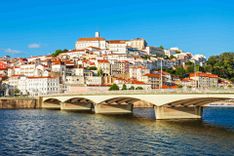


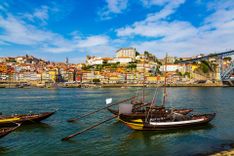










Coimbra is compact enough for walking, though the steep hills between the Baixa (lower town) and Alta (upper town) will test your legs. Most of the main sights, the university, the old cathedral, and the riverfront are within easy reach on foot, but there are also buses and taxis if you want to save energy.

Figueira da Foz, Portugal
If you’re wondering how many days in Coimbra are enough, one full day lets you cover the highlights without rushing. Start with the university and its Joanina Library, wander the medieval alleys of the Alta, then head down to the Sé Velha and the cafés of the Baixa. Finish with a stroll along the Mondego riverfront before dinner. That gives you a strong sense of the city’s history and atmosphere.
Staying overnight changes the experience. Once the day-trippers leave, Coimbra feels quieter and more authentic. You’ll hear fado spilling from courtyards, see the university lit up at night, and have the narrow streets almost to yourself.
If you’re planning a 10-day Portugal itinerary that includes central Portugal, two days in Coimbra work best. Spend one inside the city, then dedicate the second to nearby trips: the Roman ruins of Conímbriga, the forest trails of Buçaco, or the spa town of Luso. An extra night also means you can catch Coimbra at different hours, from misty mornings over the river to golden sunsets from the upper terraces.
Coimbra offers a good mix of hotels, guesthouses, and boutique stays, from riverside spots to atmospheric rooms in centuries-old buildings. Where you base yourself depends on how you like to experience the city.

Mondego River, Portugal @ Shutterstock
Coimbra is a city where history and daily life overlap at every turn. You can step from a medieval alley into a 21st-century café, or hear fado drifting through a square that has been used for student gatherings for centuries. Here are the experiences that should be high on your list.
The University of Coimbra is more than just Portugal’s oldest university. It is a living monument that has shaped the country’s intellectual and cultural life for centuries. Founded in Lisbon in 1290 and moved permanently to Coimbra in 1537, it has occupied the hilltop Royal Palace ever since. Walking through the Porta Férrea gateway is like crossing a threshold into both scholarship and ceremony. The wide courtyard, framed by whitewashed facades and baroque ornament, sets the tone. This is a place where knowledge was meant to command respect.
Inside the Paço das Escolas, you can visit the Sala dos Capelos, once a throne room for kings and now the site of academic ceremonies. The walls are lined with portraits of Portuguese monarchs and university rectors, each one gazing down on generations of students who came to defend their theses here. From the balcony outside, the view sweeps over the Mondego valley, a reminder that Coimbra’s influence extended far beyond its walls. To walk through the university is to see how Portugal’s identity as a nation of explorers and scholars was forged.
The Joanina Library is the jewel of the university and perhaps the most beautiful interior in Coimbra. Built in the early 18th century under King João V, it was designed as a statement of Portugal’s wealth during the Age of Discoveries. Every surface glitters. Gold leaf frames painted ceilings filled with allegories of knowledge, while rows of towering oak shelves hold some 300,000 volumes dating from the 16th to the 18th centuries.
What most visitors remember, however, is the atmosphere. The air is cool and still, heavy with the scent of old leather and ink. A closer look reveals ingenious details: oak was chosen for the shelves because it naturally repels insects, while colonies of bats live in the roof and emerge at night to eat any pests that threaten the books. Staff cover the tables each evening with leather cloths, a ritual that has been performed for centuries. It is these small acts of preservation, combined with the grandeur of the space, that make the library unforgettable.
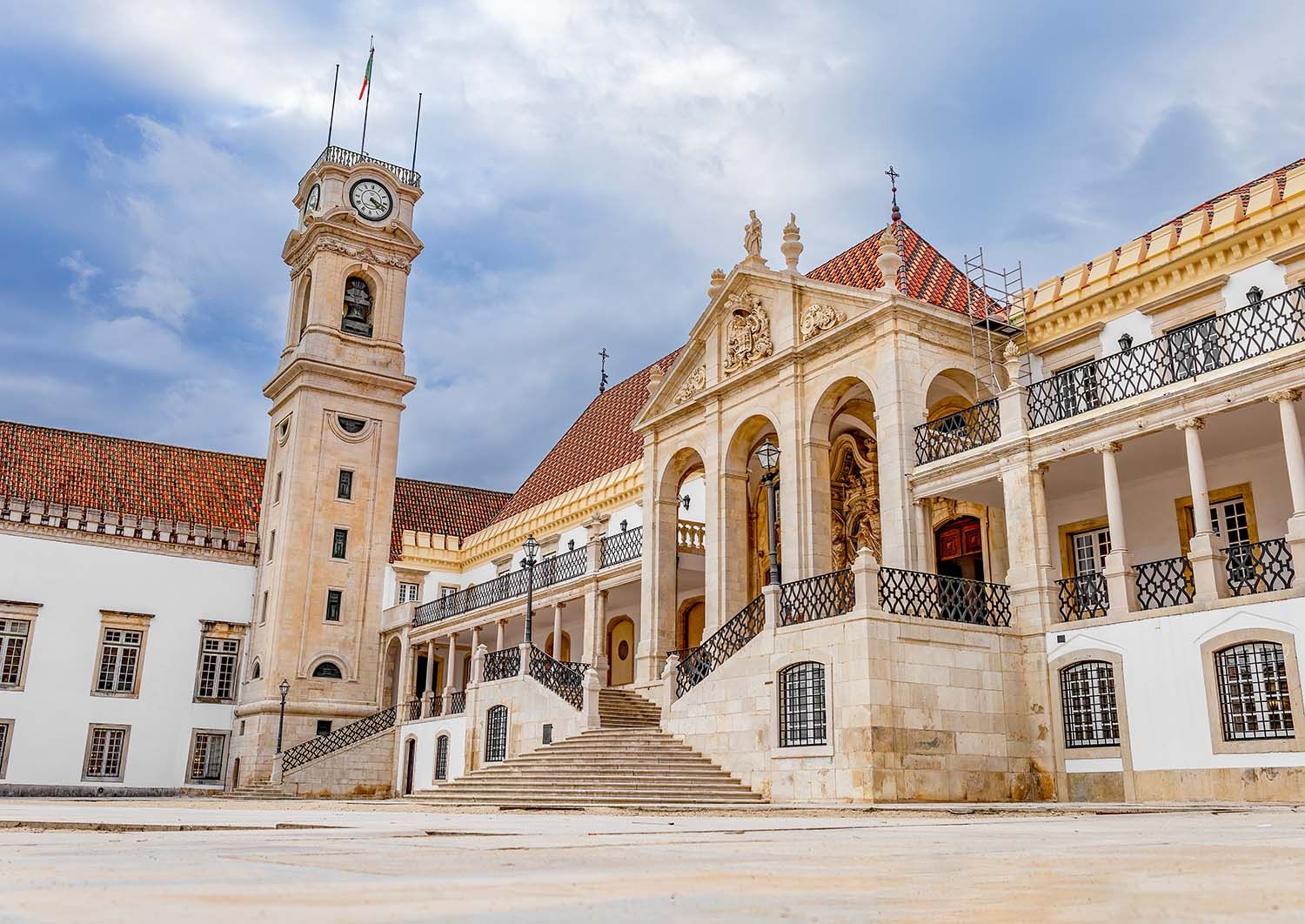
Old building of University of Coimbra in Portugal © Shutterstock
Coimbra’s Sé Velha is one of the finest surviving Romanesque cathedrals in Portugal. Built in the 12th century when the city was still a frontier stronghold, it has the appearance of a fortress, with thick stone walls and narrow windows that suggest defense as much as worship. The west façade, with its semicircular arch and intricate capitals, feels austere compared to later churches, but step inside and you are rewarded with an atmosphere of solemnity and quiet grandeur.
The cloister is a highlight. Built a century after the cathedral itself, it is filled with pointed arches decorated with delicate carvings of foliage and animals. Sunlight filters into the square courtyard, bouncing off the stone in warm tones that contrast with the shadowy nave. The Sé Velha is not a frozen relic. Every spring, during the Queima das Fitas student festival, graduates gather here for a blessing, linking their modern lives to traditions that stretch back eight centuries.
Only a short walk uphill lies the Sé Nova, or New Cathedral, a very different experience. Built in the 16th century by the Jesuits, it reflects a period when Coimbra was a confident academic center and the Counter-Reformation demanded more ornate places of worship. The interior dazzles with gilded woodcarvings, elaborate side chapels, and a monumental altarpiece that leaves no doubt about the triumph of the Catholic faith.
Seeing the Sé Velha and Sé Nova together provides a compact lesson in the evolution of Portuguese religious architecture. The first represents the era of defense and faith in balance, while the second demonstrates confidence, wealth, and a turn toward spectacle. Few cities offer such a striking contrast within a few hundred meters.
The Botanical Garden of Coimbra is one of the oldest in Europe, founded in 1772 as part of reforms to modernize the university. It was intended as a scientific laboratory where students of medicine and natural philosophy could study plants from around the world. Today, it covers more than thirty acres, a mix of manicured terraces, shaded groves, and wild corners where nature has been left to reclaim its space.
The lower garden feels formal, with fountains and ponds surrounded by exotic palms. As you climb higher, paths lead into groves of bamboo, cedar, and oak. The atmosphere is calm, often with more students than tourists, and the occasional professor reading under a tree. From the upper terraces, you get a view back over Coimbra’s old town, a vista softened by green leaves rather than stone rooftops. It is an ideal pause between the intensity of the university visit and the climb back down to the Baixa.
The Mondego River is Coimbra’s lifeline, and in recent years the city has reclaimed its banks for leisure. Wide promenades and cycling paths stretch along both sides, while pedestrian bridges provide some of the best views of the old town, climbing steeply above the water. On summer evenings, locals gather here for open-air concerts, rowing regattas, or simply to watch the sunset.
The view from the Pedro e Inês footbridge is especially striking, with the university buildings glowing above the river as the light fades. It is no coincidence that Coimbra’s poets often found inspiration here. The river is a natural stage, and the city around it provides the backdrop. A stroll along the Mondego is essential not for its monuments, but for the way it connects you to the rhythm of Coimbra life.
Across the river stands the Monastery of Santa Clara-a-Velha, one of Coimbra’s most atmospheric ruins. Founded in the 14th century by Queen Isabel, it soon fell victim to the floods of the Mondego. By the 17th century, the nuns abandoned it, moving uphill to what became the new Santa Clara convent. For centuries, the old church lay half-buried in mud until archaeological excavations uncovered it in the 20th century.
Walking among the Gothic arches today, you can still sense the struggle between human devotion and natural force. The visitor center explains how the site was excavated and preserved, while also telling the story of Queen Isabel, revered as a saint for her acts of charity. A visit here gives a different perspective on Coimbra: not just a seat of learning, but a place where faith and resilience endured in the face of natural adversity.
Sixteen kilometers south of Coimbra lies Conímbriga, the most extensive Roman site in Portugal. Unlike smaller ruins scattered across the country, Conímbriga feels like a complete city, with streets, walls, baths, and villas that reveal daily life two thousand years ago. The mosaics are extraordinary. Floors are decorated with intricate hunting scenes, mythological figures, and geometric designs that remain vivid despite the centuries.
The site also illustrates the layers of history that shaped the region. The Romans built defensive walls during times of instability, some of which are still standing, while later medieval inhabitants reused parts of the town. A modern museum displays artifacts found during excavations, from coins to pottery, giving you an intimate look at the lives once lived here. Allow at least half a day, and if possible, combine your visit with a countryside lunch in a nearby village to round out the experience.
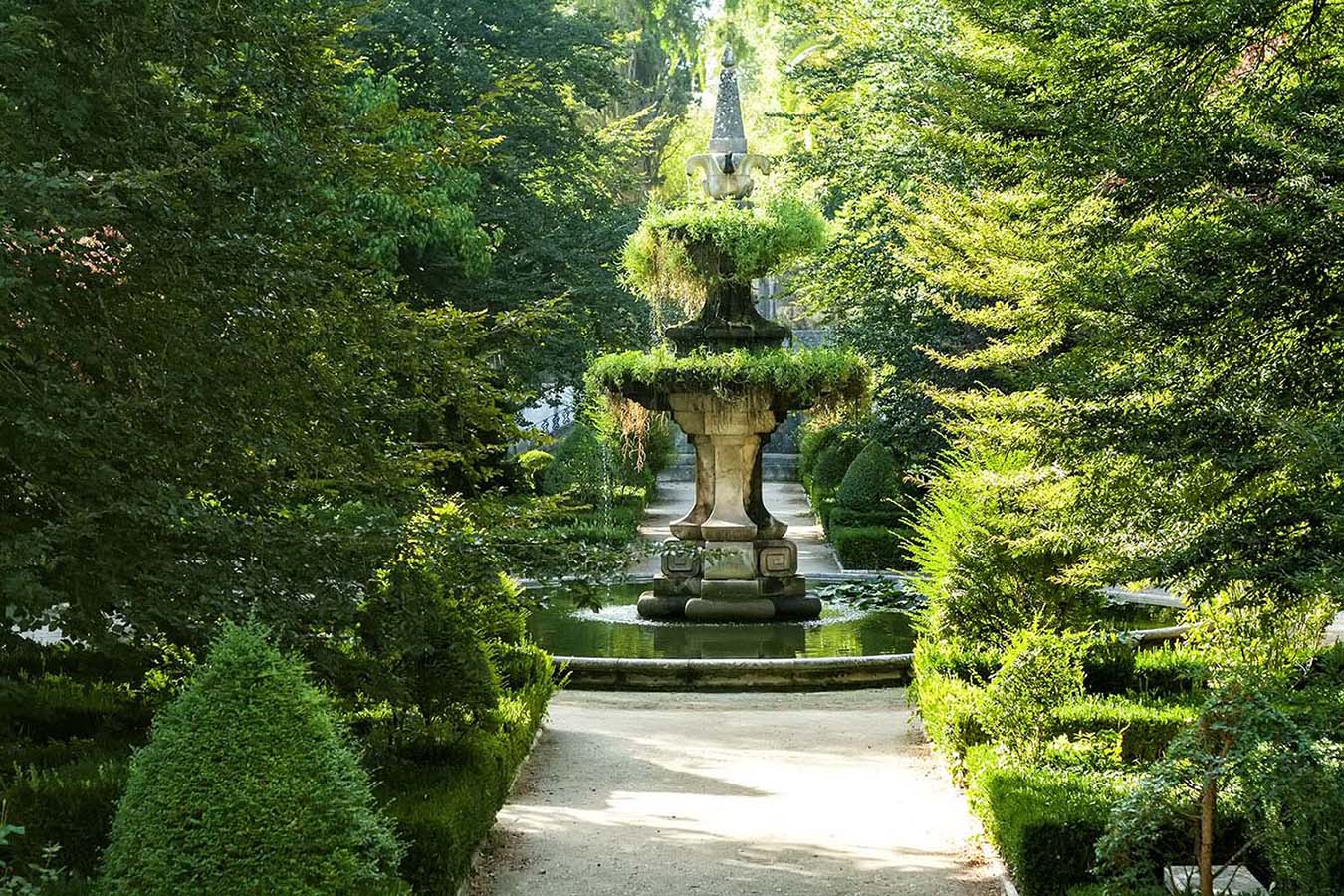
Coimbra botanical garden, Portugal © Shutterstock
Fado in Coimbra is different from the more famous Lisbon version. Here, it is performed only by men, often students or graduates of the university, dressed in black academic capes. The lyrics focus less on fate and longing, and more on love, nostalgia, and the bittersweet passage of student life. Performances are held in intimate taverns in the old town, where candlelight and vaulted ceilings create a hushed atmosphere.
The music has a strong link to ritual. During academic festivals, groups of singers gather in the streets and squares, their voices echoing across the stone walls long after midnight. Attending a fado performance in Coimbra is not just about music. It is about entering a tradition that continues to connect generations of students with the city that shaped them.
An hour north of Coimbra lies the Buçaco Forest, a landscape that feels almost enchanted. For centuries, it was cared for by Carmelite monks, who planted exotic species and built small hermitages and chapels along winding paths. The forest later became a royal retreat, and in the 19th century it was crowned by the Buçaco Palace, a neo-Manueline fantasy that now serves as a hotel.
The forest offers a complete contrast to Coimbra’s urban intensity. Towering trees form a dense canopy, under which moss-covered fountains and quiet clearings appear at unexpected turns. Trails lead to viewpoints where you can see across the Serra do Buçaco and into the surrounding countryside. It is also a place of history: the Battle of Buçaco in 1810 saw Anglo-Portuguese forces defeat Napoleon’s army, and monuments to the victory are scattered among the trees. Visiting Buçaco combines natural beauty, historical depth, and a sense of timelessness that makes it one of the most rewarding day trips from Coimbra.
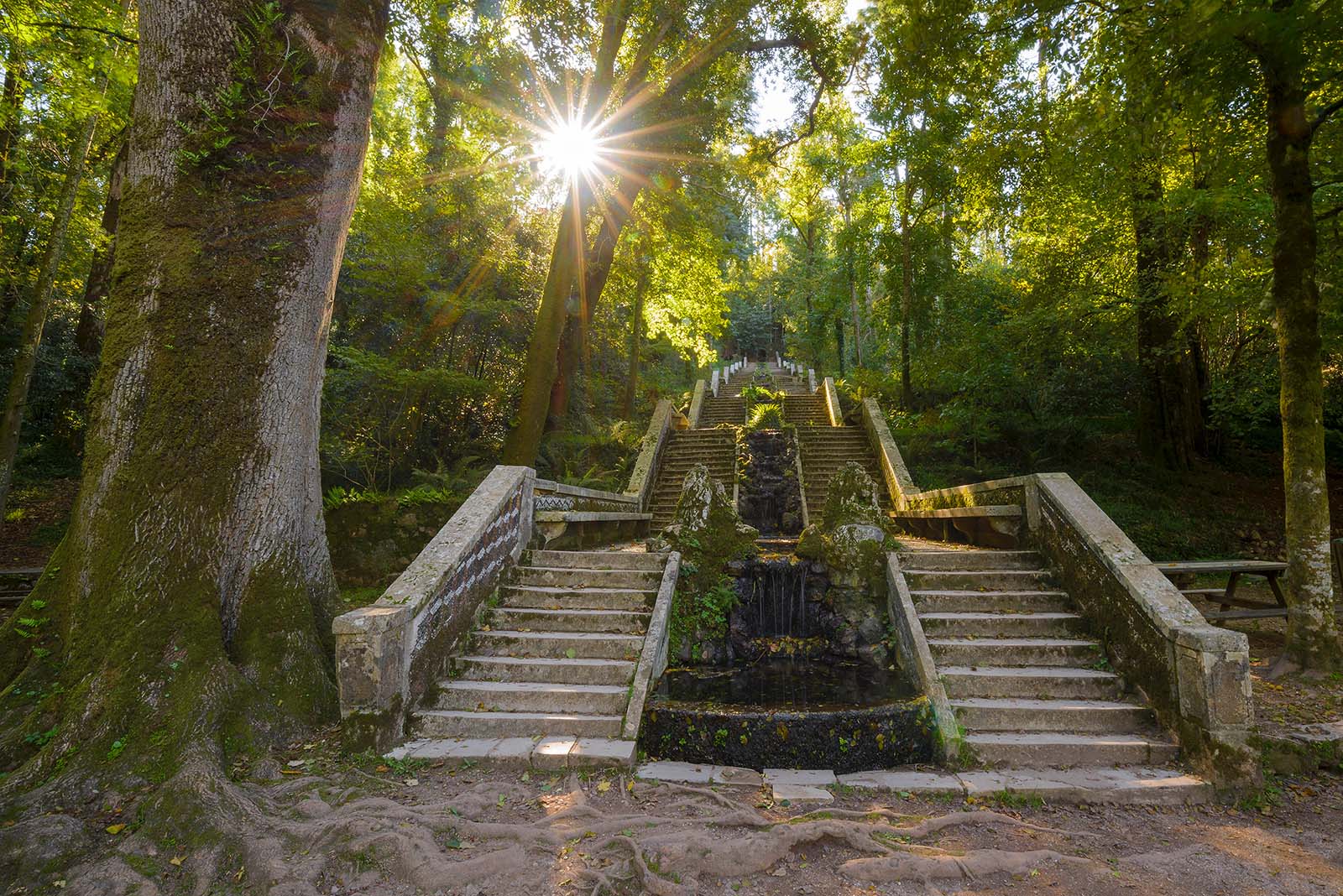
Fonte Fria It is the most famous fountain in Bucaco forest in Luso, Portugal © Shutterstock
Coimbra has a Mediterranean climate shaped by strong Atlantic influence. Summers are warm and mostly dry, winters are mild but wetter, and the seasons in between bring some of the city’s most inviting conditions. Because Coimbra sits on the Mondego River and rises steeply toward the university quarter, mornings can be misty, and the upper streets of the Alta often feel a little cooler than the Baixa along the water. Average daytime temperatures range from about 46°F (8°C) in January to 82°F (28°C) in August. Summers are hot but rarely as extreme as the Alentejo, while winters tend to be damp rather than harsh. If you are comparing destinations for the best time to visit Portugal, Coimbra offers a comfortable middle ground almost year-round.
Coimbra is more than its university and fado halls. The city has a strong food identity shaped by the river, the nearby mountains, and centuries of student life. You’ll find taverns where pork roasts for hours, elegant dining rooms serving updated classics, and cafés where generations of students have scribbled lecture notes over coffee and pastries.
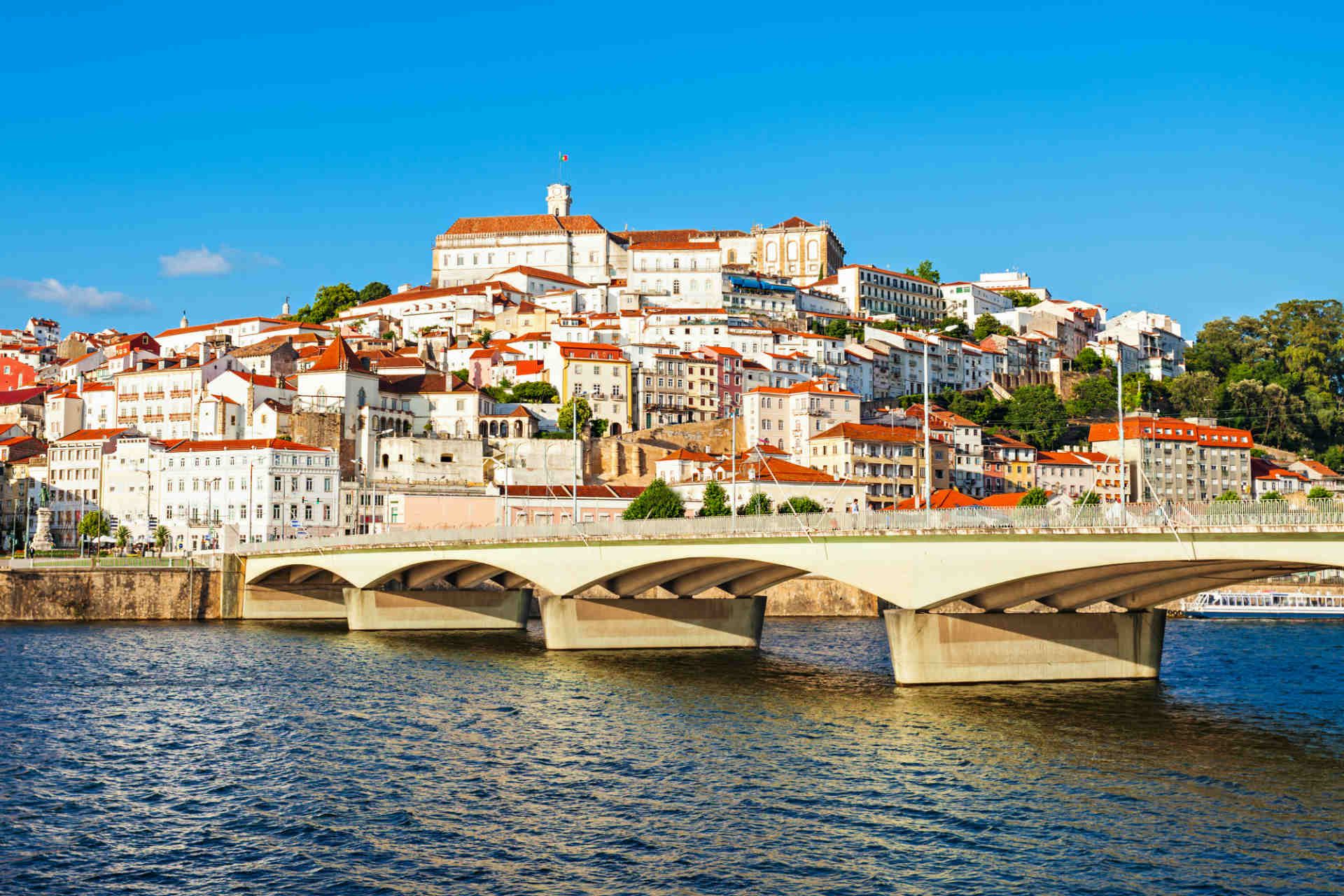
Coimbra, Portugal © saiko3p/Shutterstock
Here are some private and flexible experiences we can arrange for your tailor-made Coimbra trip, designed by our local experts.
Discover Portugal's most captivating stories
Portugal Travel GuideUse Rough Guides' trusted partners for great rates
written by
Olga Sitnitsa
Online editor at Rough Guides, specialising in travel content. Passionate about creating compelling stories and inspiring others to explore the world.